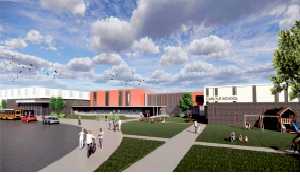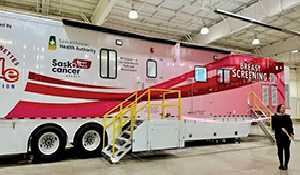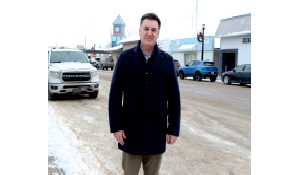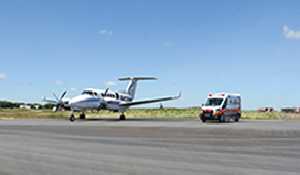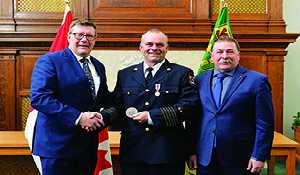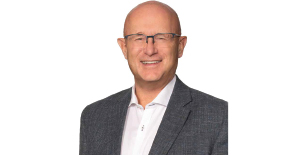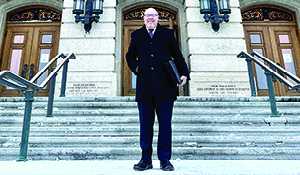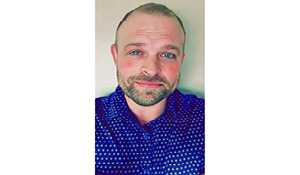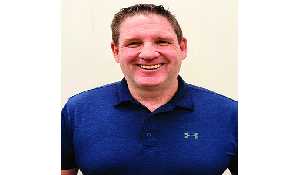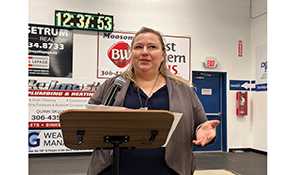Hindley says in-patient treatment beds will be part of addictions spaces rollout
May 24, 2023, 9:33 am
Kevin Weedmark


The province is in the midst of rolling out 150-200 addictions treatment spaces across Saskatchewan. So far 62 spaces have been announced but they are all post-treatment housing, or virtual treatment spaces. None of the spaces announced so far are in-patient treatment spaces, for which there are long waiting lists. There were proposals submitted from around the province for in-patient facilities, and the World-Spectator reached out to Addictions and Mental Health Minister Everett Hindley last week to ask if there will be some in-patient spaces included in the program.
The full interview with editor Kevin Weedmark follows.
When this program was first announced was the intention to have a whole range of treatment options under the program?
When we first announced that we’d be adding another 150 more treatment spaces, the reason we stated it that way is because we had an idea of what might come in, in terms of proposals and submissions from various organizations and groups. But I don’t think we fully knew what might come in so we didn’t want to limit it by saying, “Okay, it will just be inpatient intensive treatment spaces,” in case a group or an organization comes in saying, “Hey, we can offer this or that as part of the continuum of service.”
So we purposely left it wide open that way, also based on what I’ve been seeing as minister and what we as the government have been seeing happening in other jurisdictions, knowing that there are some different approaches to how you offer treatment for addictions.
So that’s why, as you’re starting to see the roll out of this in a variety of different phases here, some less traditional methods for treatment in terms of adding capacity to the system.
At this point three different projects have been announced. Do you have any idea at this point how many projects there will be across the province in the end? Where are you at in the process—are you talking to the proponents one-by-one?
We had the RFP (Request for Proposals) process open last summer in which we had encouraged groups or organizations who had been contacting government or just been following this issue and want to provide assistance in providing treatment capacity, and we allowed for that process for submissions to come through.
Now as a result of that, when the Request for Proposals closed early last fall, in September, obviously there was a number of different submissions that came in from across the province. Some are more ready than others to be implemented quickly.
So I think what you’ve seen in the first phase and in the start of the second phase, is some of the submissions that came through that were reviewed by officials that were deemed to be beneficial and would have been approved. But these are ones that are easier to implement in a quicker time frame. So that would be the 14 and 12 post treatment beds at St. Joseph’s Addictions Recovery Centre in Estevan where they already have some established programming, but as a result of the space that they currently have, they were able to provide and submit a proposal that included the use of that for post treatment beds—which is important because you have pre-treatment beds, you have treatment beds, and post-treatment beds, and they’re all important when it comes to the continuum of support for people struggling with addictions.
The other component that’s been announced thus far is the 36 virtual spaces from Edgewood and that is a newer method of treatment for those dealing with mild to moderate addictions. That doesn’t necessarily replace the actual physical inpatient beds but I think it’s an important component. When Edgewood made their submission as part of the RFP process, they had indicated that they would be able to get these operational—I believe they’re doing it in one other jurisdiction in Canada right now so they have a bit of a track record in this, but they indicated that they could get these operational quite quickly. So that was something that was announced as well.
There are still a number of other successful proponents. I’m not sure how many, I don’t know the number off the top of my head, but these would be ones that are deemed to be successful and are being negotiated with our officials and we’ll make some announcements as they become ready to be announced.
Some of these would include actual creation of new inpatient treatment beds that do not exist now.
Whether it’s construction of a facility, brand new from scratch, that could be a possibility.
You might also have some where a group has submitted a proposal that involves taking an existing facility, one that’s perhaps being used for other purposes or maybe isn’t being used at all, and their proposal may include creating spaces that might require some renovations to a building.
So they’re things that might take a little bit longer but they’re being negotiated as part of the process and will be announced as they’re ready to go.
I know there are some pretty significant waiting lists at some facilities for inpatient addictions treatment. Any idea how many of these phases will be set aside for inpatient treatment?
At this point in time I’m not able to say how many there would be. You look at the number of treatment spaces that we’ve announced thus far and out of the 62 of them so far in total—the 36 virtual spaces and 26 new post-treatment spaces—and I’m fairly confident that the target we set of at least 150 treatment spaces, that we will achieve that.
Based on what I’ve been told in terms of the number of submissions that came in and the different proposals that were submitted, we will definitely be able to hit that target of 150 treatment spaces, keeping in mind that we’ve budgeted for this, not just in one budget year, knowing that we can’t get these all off the ground and operational all at once.
It takes a bit of a staged approach depending on the readiness of the projects, but I’m fairly confident in saying that there will be new inpatient treatment beds that will be announced in the phases yet to come.
What is the timeline? How long will it take to get through all of these submissions make all of the announcements and have these beds in place?
It’s tough to put a timeline on it. We have funding in this year’s budget for some spaces. So we’ve got $2.1 million provided in last year’s budget and $2.3 million in this year’s budget, and as we start to see these getting operational and as we start to announce more successful proponents and have them ready to be launched, you’ll see additional funding dedicated towards that in future budget cycles.
So we’re hopeful. Myself as minister and us as government are hopeful—we’d like to see these all open as quickly as possible, given the circumstances, that that’s not realistic either.
So we have our teams working very aggressively to make sure that we’re negotiating with the successful proponents and hoping to get these announcements as quickly as we can. I hope that as we roll through Phase 2, that we have further announcements that we can make in the weeks and months ahead, but I do believe that some will stretch into next year’s budget as well.
Hindley responds to question on CT Scanner
I want to ask you a question about the CT scanner for Moosomin as well. We’re just looking at some new population projections and population stats for the area.
When you go within 100 kilometers of Moosomin, where there is no CT Scanner, you have a population of 56,786, and within 100 kilometers of Estevan, where there is a CT Scanner, you’ve got 44,939 people.
So about 12,000 more within the area served by Moosomin. When we look at the projections, Moosomin is projected to grow by 20 per cent up to 2032 and Estevan is projected to lose about 2 per cent of its population.
Given that, what would be your advice to the groups in Moosomin that would like to see a CT scanner? They believe that they have the numbers on their side—what should they be doing to try to bring a scanner into the community?
We’ve had the opportunity to talk about this on a number of occasions and the MLA for that area, Steven Bonk, has raised this with me as well. We’ve had a number of discussions about it. It’s a priority for him and of course for Moosomin and the surrounding area.
When it comes to budget decisions for the Ministry of Health, we take a look at all of those sorts of metrics that you’ve pointed out and we’ve seen it, we’ve done that in the past on previous projects and those that are underway.
I would point to long-term care facilities that have more beds now than what their predecessors had, and that goes back to projects, such as for example, the long term care facility in Swift Current that went from 194 beds in the previous three separate facilities to now 225 beds in that newer facility that was opened a handful of years ago.
In La Ronge we are in the process of working through and getting a start on the construction for a new long-term care facility in La Ronge. The current one is 16 beds and the new facility. will be an 80-bed facility and that logic also would apply to the provision of health care services.
I know that the CT scanner has been for quite some time and continues to be a priority for the people of Moosomin and area. I know when Minister Merriman, the Minister of Health, and I had conversations as we’re planning for the budget cycle, we look at where we have pressures and where we have growth, and as we’re making these decisions, how do we prepare for the future?
I would argue that was put on display this past budget when we made an announcement regarding a new hospital integrated facility in Esterhazy. Again, because we have a couple of facilities there that have been around for quite some time. They’ve been in place for decades and of course are showing their age, but that area is also growing in population as well.
So when it comes to these decisions, those are the sort of the information and metrics that we look at.
I continue to have conversations and it has been raised to me on a regular basis by MLA Steven Bonk and I know that individuals and groups from the town write emails to me as the minister and Minister Merriman and we’d encourage them to continue to do so—it’s a conversation that we will definitely have with our officials as we plan for the future.


